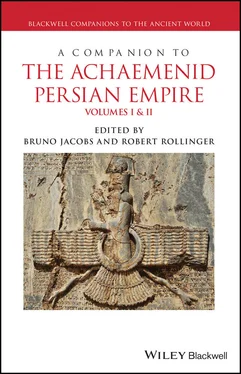31 Rollinger, R. (2003c). s. v. Herodotus. In E. Yarshater (ed.), Encyclopaedia Iranica 12 (3). New York: Columbia University Center for Iranian Studies, pp. 254–288.
32 Rollinger, R. (2004). “Medien”. In W. Eder, J. Renger (eds.), Herrscherchronologien der antiken Welt: Namen, Daten, Dynastien Der Neue Pauly – Supplemente, Band 1. Stuttgart‐Weimar: Metzler, pp. 112–115.
33 Rollinger, R. (2005). Das Phantom des Medischen ‘Großreiches’ und die Behistun‐Inschrift. In E. Dąbrowa (ed.), Ancient Iran and its Neighbours: Studies in Honour of Prof. Józef Wolski on Occasion of his 95th Birthday Electrum 10. Kraków: Jagiellonian University Press, pp. 11–29.
34 Rollinger, R. (2007). s. v. Rhages. Reallexikon der Assyriologie und Vorderasiatischen Archäologie, 11 (5/6), Lieferung, pp. 340–341.
35 Rollinger, R. (2009). The Median “Empire”, the end of Urartu and Cyrus' the Great campaign in 547 BC (Nabonidus chronicle II 16). Ancient West & East, 7, pp. 49–63.
36 Rollinger, R. (2010). Das medische Königtum und die medische Suprematie im sechsten Jahrhundert v. Chr. In G.B. Lanfranchi, R. Rollinger (eds.), Concepts of Kingship in Antiquity: Proceedings of the European Science Foundation Preparatory Workshop Held in Padova, November 28th – December 1st, 2007 History of the Ancient Near East/Monographs 10. Padova: S.a.r.g.o.n., pp. 63–85.
37 Rollinger, R. (2011). Ktesias' Medischer Logos. In. J. Wiesehöfer, R. Rollinger, and G.B. Lanfranchi (eds.), Die Welt des Ktesias – Ctesias' World Classica et Orientalia 1. Wiesbaden: Harrassowitz, pp. 313–350.
38 Rollinger, R. (2014). Von Kyros bis Xerxes: Babylon in persischer Zeit und die Frage der Bewertung des herodoteischen Geschichtswerkes – eine Nachlese. In M. Krebernik, H. Neumann (eds.), Babylonien und seine Nachbarn in neu‐ und spätbabylonischer Zeit: Wissenschaftliches Kolloquium aus Anlass des 75. Geburtstags von Joachim Oelsner Alter Orient und Altes Testament 369. Münster: Ugarit‐Verlag, pp. 147–194.
39 Rollinger, R. (2015). Royal strategies of representation and the language(s) of power: some considerations on the audience and the dissemination of the Achaemenid royal inscriptions. In S. Procházka, L. Reinfandt, and S. Tost (eds), Official Epistolography and the Language(S) of Power: Proceedings of the 1st International Conference of the NFN “Imperium and Officium”: Comparative Studies in Ancient Bureaucracy and Officialdom, University of Vienna, 10–12 November 2010 Papyrologica Vindobonensia 8. Vienna: Verlag der Österreichischen Akademie der Wissenschaften, pp. 117–130.
40 Rollinger, R. (2020a). The Medes of the 7th and 6th c. BCE: a short‐term empire or rather a short termed confederacy? In R. Rollinger, J. Degen, and M. Gehler, (eds.), Short‐termed empires in world history Universal‐ und kulturhistorische Studien/Studies in Universal and Cultural History. New York: Springer 2020, pp. 187–211.
41 Rollinger, R. (2020b). Contextualizing the Achaemenid‐Persian Empire: What does empire mean in the First Millennium BCE? In G. P. Basello, P. Callieri, and A. V. Rossi (eds.), Achaemenid Studies Today. Naples: L'Orientale" University 2020, in press.
42 Rollinger, R., Kellner, A. (2019). Once More The Nabonidus Chronicle (BM 35382) and Cyrus’ Campaign in 547 BC. Ancient West & East 18, pp. 153–176 (doi: 10.2143/AWE.18.0.3287212)
43 Rollinger, R., Truschnegg, B., and Bichler, R. (2011) (eds.), Herodot und das Persische Weltreich (Herodotus and the Persian Empire) Classica et Orientalia 3. Wiesbaden: Harrassowitz.
44 Rossi, A.V. (2010). Elusive identities in pre‐Achaemenid Iran: the Medes and the Median language. In C.G. Cereti (ed.), Iranian Identity in the Course of History Serie Orientale Roma 105, Orientalia Romana 9. Rome: Istituto Italiano Per L’Africa E L’Oriente, pp. 289–330.
45 Rossi, A.V. (2017) “… how Median the Medes were”? État d’une question longuement débattue. In W.F.M. Henkelman and C. Redard (eds.), Persian Religion in the Achaemenid Period – La religion perse à l’époque achéménide. CleO 16. Wiesbaden, pp. 462–496.
46 Sancisi‐Weerdenburg, H. (1988). Was there ever a Median Empire? In A. Kuhrt, H. Sancisi‐Weerdenburg (eds.), Method and Theory: Proceedings of the London 1985 Achaemenid History Workshop Achaemenid History 3. Leiden: Nederlands Instituut voor het Nabije Oosten, pp. 197–212.
47 Sancisi‐Weerdenburg, H. (1995). Medes and Persians in early states? In M.A. van Bakel, J.G. Oosten (eds.), The Dynamics of the Early State Paradigm. Utrecht: ISOR, pp. 87–104.
48 Sarraf, M.R. (2003). Archaeological excavations in Tepe Ekabatana (Hamadān) by the Iranian archaeological mission between 1983 and 1999. In G.B. Lanfranchi, M. Roaf, and R. Rollinger (eds.), Continuity of Empire (?): Assyria, Media, Persia History of the Ancient Near East/Monographs 5. Padova: S.a.r.g.o.n., pp. 169–280.
49 Schmitt, R. (2003). Die Sprache der Meder – eine große Unbekannte. In G.B. Lanfranchi, M. Roaf, and R. Rollinger (eds.), Continuity of Empire (?): Assyria, Media, Persia History of the Ancient Near East/Monographs 5. Padova: S.a.r.g.o.n., pp. 23–36.
50 Seidl, U. (1994). Achaimenidische Entlehnungen aus der urartäischen Kultur. In A. Kuhrt, M.C. Root, and H. Sancisi‐Weerdenburg (eds.), Continuity and Change: Proceedings of the Last Achaemenid History Workshop, April 6–8 1990, Ann Arbor Achaemenid History 8. Leiden: Nederlands Instituut voor het Nabije Oosten, pp. 107–129.
51 van der Spek, R.J. (2014). Cyrus the Great, exiles, and foreign gods: a comparison of Assyrian and Persian policies on subject nations. In M. Kozuh, W.F.M. Henkelman, C.E. Jones, and C. Woods (eds.), Extraction & Control: Studies in Honor of Matthew W. Stolper. Chicago: The Oriental Institute of the University of Chicago, pp. 233–264.
52 Stronach, D. (2003). Independent media: archaeological notes from the homeland. In G.B. Lanfranchi, M. Roaf, and R. Rollinger (eds.), Continuity of Empire (?): Assyria, Media, Persia History of the Ancient Near East/Monographs 5. Padova: S.a.r.g.o.n., pp. 233–248.
53 Tuplin, C. (2005). Medes in Media, Mesopotamia, and Anatolia: empire, hegemony, domination or illusion? Ancient West & East, 3, pp. 229–251.
54 Waters, M. (2005). Media and its discontents. Journal of the American Oriental Society, 125 (4), pp. 517–533.
55 Matthew, W. (2017). Ctesias’ Persica in Its Near Eastern Context. Wisconsin: The University of Wisconsin Press.
56 Wiesehöfer, J. (2003). The Medes and the idea of the succession of empires in antiquity. In G.B. Lanfranchi, M. Roaf, and R. Rollinger (eds.), Continuity of Empire (?): Assyria, Media, Persia History of the Ancient Near East/Monographs 5. Padova: S.a.r.g.o.n., pp. 391–396.
57 Wiesehöfer, J. (2005). Daniel, Herodot und “Dareios der Meder”: Auch ein Beitrag zur Idee der Abfolge von Weltreichen. In R. Rollinger (ed.), Von Sumer bis Homer: Festschrift Manfred Schretter zu seinem 60. Geburtstag am 25. Februar 2004 Alter Orient und Altes Testament 325. Münster: Ugarit‐Verlag, pp. 647–653.
58 Wiesehöfer, J., Rollinger, R. and Lanfranchi, G.B. (2011) (eds.). Die Welt des Ktesias – Ctesias' World Classica et Orientalia 1. Wiesbaden: Harrassowitz.
Lanfranchi, Roaf, and Rollinger 2003 (together with Waters 2005 and Rollinger 2020a) present the best and most comprehensive overview on all available sources of the “Median dilemma” and the problems connected with this issue. Adali 2011 offers a broad introduction to the concept of the ethnic term Umman‐manda in Mesopotamian sources. Sancisi‐Weerdenburg 1988 and 1995, as well as the less well‐known but nevertheless excellent paper Kienast 1999 are still masterpieces of historical analysis of the problem. This also goes for Liverani 2003. On Herodotus and Ctesias see the various contributions in Rollinger, Truschnegg, and Bichler 2011, and Wiesehöfer, Rollinger, and Lanfranchi 2011; cf. also Waters 2017. For the problems connected with the reconstruction of the Median language, Rossi 2010 and 2017 are excellent introductions.
Читать дальше












